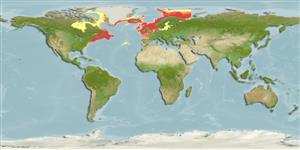Environment: milieu / climate zone / نطاق العمق / distribution range
البيئة
بحري قاعية التغذية و المعيشة; محيطية (Ref. 51243); نطاق العمق 0 - 868 m (Ref. 58496), usually 50 - 150 m (Ref. 4701). Polar; 3°C - 11°C (Ref. 127841); 80°N - 32°N, 95°W - 49°E
Western Atlantic: Nunavut, Hudson Bay to James Bay and Labrador in Canada to New Jersey in USA; rarely to Chesapeake Bay in USA and Bermuda. Eastern Atlantic: Barents Sea, Iceland and Greenland to Spain (Ref. 4701).
الحجم / وزن / العمر
النضج: Lm ? range ? - ? cm
Max length : 61.0 cm TL ذكر/ مختلط الجنس; (Ref. 58426); 42.9 cm SL (female); أعلا وزن تم نشرة: 9.5 kg (Ref. 4701); أعلا وزن تم نشرة: 9.5 kg; العمر: 13 سنين (Ref. 54207)
الأشواك الظهرية (المجموع) : 5 - 9; الأشعة الظهرية الناعمة (المجموع) : 9 - 11; شوكة شرجية: 0; أشعه شرجية لينه: 9 - 10; فقرات: 28 - 29. First dorsal fin present but covered by thick layer of skin forming a characteristic high crest with embedded spines. Bony tubercles present, arranged in 3 widely separated rows of large flattened tubercles on each side of body. Gill openings large, extend- extending below level of upper pectoral fin ray. Pyloric present 36-79. Ventral sucking disc formed by the modified pelvic fin (Ref. 232).
Body shape (shape guide): short and / or deep; Cross section: angular.
Basically solitary rather than a schooling fish. They exhibit a homing instinct (Ref. 9737). Adults inhabit rocky bottoms but may occur among floating seaweed. They migrate considerable distances in an annual cycle between deeper waters in winter and shallower waters in summer (Ref. 26141). Maximum depth reported at 868 m (Ref. 58426). Epibenthic-pelagic (Ref. 58426). Juveniles are found among algal clumps in bays and fjords moving offshore as they mature (Ref. 96431). During the spawning season the males become reddish in color on the underside, whereas females turn blue-green. Adults feed on ctenophores, medusas, small crustaceans, polychaetes, jelly fish and small fishes. Valued for their eggs, which make an inexpensive caviar (Ref. 9988). Eaten in Nordic countries, marketed fresh or smoked. Male flesh is most demanded and roe is sold fresh (Ref. 35388).
Eggs are laid in large numbers on stony bottoms (Ref. 9900). Male guards egg-mass aggressively.
Stein, D.L., 1986. Cyclopteridae. p. 1269-1274. In P.J.P. Whitehead, M.-L. Bauchot, J.-C. Hureau, J. Nielsen and E. Tortonese (eds.) Fishes of the North-eastern Atlantic and the Mediterranean. UNESCO, Paris. Vol. III. (Ref. 4701)
IUCN Red List Status (Ref. 130435: Version 2025-1)
استخدامات بشرية
مصائد: ذو قيمة تاجرية عالية; طعم: usually
أدوات
تقارير خاصة
Download XML
مصادر علي الأنترنت
Estimates based on models
Preferred temperature (مرجع
123201): 0.6 - 11.4, mean 7.1 °C (based on 732 cells).
Phylogenetic diversity index (مرجع
82804): PD
50 = 1.0000 [Uniqueness, from 0.5 = low to 2.0 = high].
Bayesian length-weight: a=0.02630 (0.01091 - 0.06342), b=2.99 (2.77 - 3.21), in cm total length, based on LWR estimates for this (Sub)family-body shape (Ref.
93245).
مستوى غذائي (مرجع
69278): 3.9 ±0.0 se; based on diet studies.
المرونه (مرجع
120179): منخفض, الحد الزمني الأدني لتضاعف عدد أفراد المجتمع 4.5-14 سنة (K=0.12; tm=3-5; tmax=13; Fec=100,000).
Prior r = 0.15, 95% CL = 0.10 - 0.22, Based on 1 full stock assessment.
Fishing Vulnerability (Ref.
59153): Moderate to high vulnerability (47 of 100).
🛈
Climate Vulnerability (Ref.
125649): Low to moderate vulnerability (26 of 100).
🛈
Nutrients (Ref.
124155): Calcium = 14 [4, 76] mg/100g; Iron = 0.419 [0.153, 1.089] mg/100g; Protein = 14 [11, 18] %; Omega3 = 0.423 [0.162, 1.406] g/100g; Selenium = 26.2 [8.8, 69.4] μg/100g; VitaminA = 13.4 [2.4, 72.4] μg/100g; Zinc = 0.52 [0.20, 0.90] mg/100g (wet weight); based on
nutrient studies.
